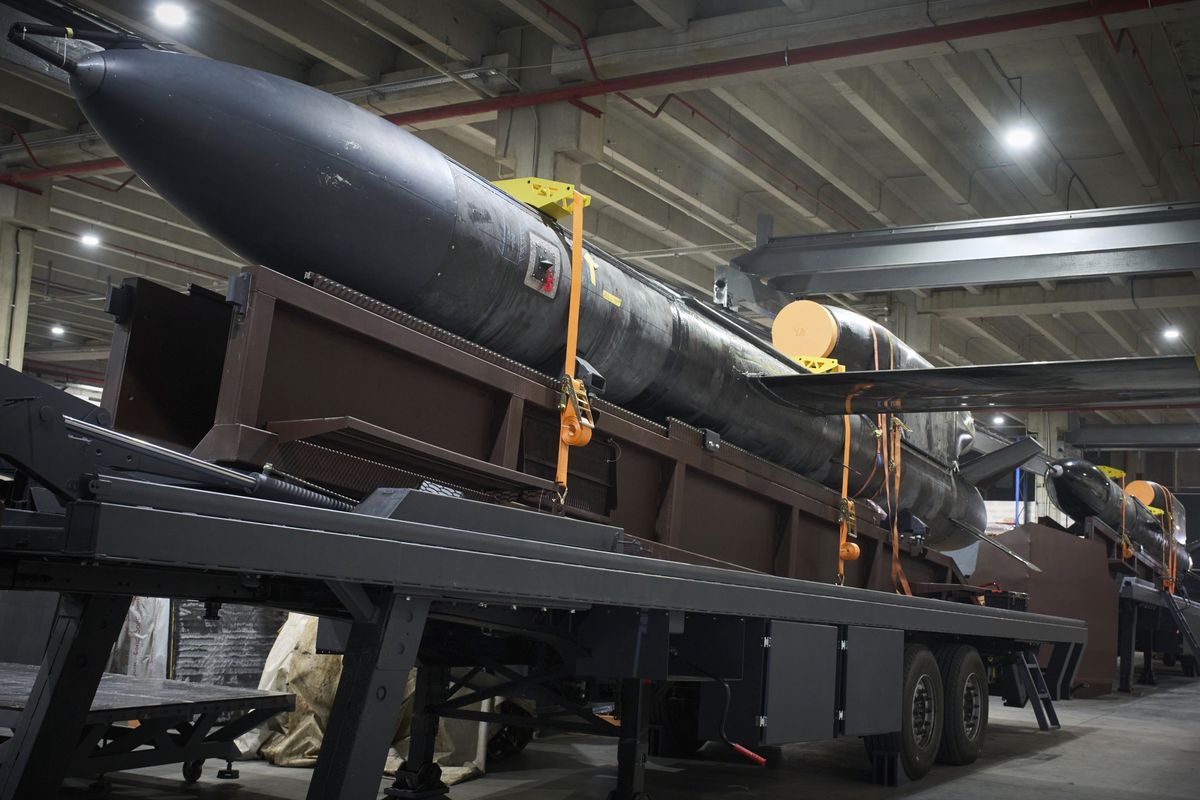EXPERT INTERVIEWS – In an age of rapidly changing technology and profound implications for the wars of the future, is the United States adapting effectively, and quickly enough? Experts are divided on the question - and while many have noted that the U.S. military and defense sectors are learning valuable lessons about modern warfare and technology from the conflict in Ukraine, many believe that the innovations in the U.S. aren't happening fast enough.
Recently, U.S. Air Force Colonel Maximillian Bremer, Chief of the Advanced Program Division at the U.S. Air Mobility Command, and Kelly Grieco, Senior Fellow at the Stimson Center’s Reimagining U.S. Grand Strategy Program, co-authored an article piece in The New York Times under the heading, “Reimagining the American War Machine.“ Their contention: the U.S. military is too risk-averse in its planning and procurement strategies, and is in danger of being outpaced in many spheres by China, and finding itself insufficiently prepared for future wars.
Cipher Brief Managing Editor Tom Nagorski spoke with Grieco and Colonel Bremer about these issues, and their concerns.
"The military is a very risk-averse organization, and justifiably so — when the military fails, the nation fails," Col. Bremer said. "So there has to be a certain amount of risk aversion, but there is a big difference between acute risk aversion and chronic risk aversion. When we try to manage both, and be risk averse in both areas, we run into problems."
Grieco echoed that concern, and noted that China in particular is racing ahead without the constraints imposed by a risk-averse approach. "We need to acknowledge that we are facing adversaries that are adaptive and creative," she said. "American ingenuity has always been one of our core strengths."
The following excerpts have been edited for length and clarity. You can hear the full conversation at The Cipher Brief video channel. Colonel Bremer wanted it known that the views he expressed were not necessarily those of the U.S. military.
The Cipher Brief: Let's talk about the problem first. What do you think needs fixing?
Grieco: When we're thinking about innovation and the future of warfare, the DoD has a real challenge, which is trying to predict what it will look like in the future. Militaries are averse to risk. It makes sense. This is a serious business, trying to predict the future. And so they try to manage that uncertainty. And the tendency in managing uncertainty is to look at what's worked in the past and say, Well, that's worked, so we should do that again in the future. That works when warfare is not changing very rapidly and technology is not changing very rapidly. The problem is that today, when technologies are rapidly changing and we're seeing tremendous changes on the battlefield, it's actually creating risk that's not appreciated.
Col. Bremer: The military is a very risk-averse organization, and justifiably so — when the military fails, the nation fails. So there has to be a certain amount of risk aversion, but there is a big difference between acute risk aversion and chronic risk aversion. When we try to manage both and be risk averse in both areas, we run into problems.
It is much easier, especially within the acquisition process, to make small changes to weapons systems, to incrementally increase their capability, because we know that they've worked in the past, and so we can bet on them working in the future just a bit better. But when there are major changes technologically, when you change from an industrial age to an information age, fundamentally the way warfare is fought will change. And the military has to change with that, which means we have to bet on a changing future, not a static future.
The Cipher Brief: There are large enterprises within the Pentagon and the defense industrial system that do nothing but work on innovation. Are they not doing the work you are talking about?
Grieco: There have been good efforts to try to address this in ways with different innovation cells, the Replicator initiative and so forth. The issue is that if you actually look at the percentage of the budget that these programs represent, it is really small. And even many of these programs are a little less than meets the eye sometimes. The Replicator initiative was getting tens of thousands of new drones, whereas in Ukraine, they're using millions a year. So the scale is not quite there, which is one of the real issues. The majority of money is being spent on smaller numbers of expensive, exquisite systems — the B-21, submarines, carriers — which we may still need, but we probably need a course correction in terms of how much we're spending on those programs versus these new innovative technologies that give us more options.
Col. Bremer: I don't think that innovation comes from the military. The incentives are just not there. I work with some awesome folks at AFWERX and DIU (Defense Innovation Unit) that are really into innovation. But innovation is taking something that currently exists and using it in a very different way. And that is going to come from industry. That is our comparative advantage over directed economies. We can have a lot of industrial efforts that fail and that's OK. Companies can fail, but the military can't. Innovation by definition is going to come from the civilian sector. Our job in the military should be to present them with the problems – here's what we can't do, or here's where we see challenges in the future. So while we do have a lot of innovation efforts going on, the structural incentives to create things that are going to fail a lot are just not there. In the military, we don't like failure.
The Cipher Brief: One specific case you brought up of an innovation that has gone painfully slowly was the “quad squads,” which were quadcopter drones for individual units. This was kicked around almost a decade ago, is that right?
Grieco: It was. The Marine Corps commandant at the time announced that the goal was for every Marine squad to have a quadcopter. And that still hasn't happened. I reached out to some Marines who are commanding infantry to ask if this had happened. Some of them have the quadcopters, but not all of them. There are two reasons for this. One is that the U.S. doesn’t actually have its own domestic drone industry that can support this kind of effort. Most of the drones, about 80 to 90 percent of them today, are actually produced by China. There are some U.S. firms that make them, but they're much more expensive. And the volume they produce is 5,000-6,000 a month, so it's very small.
The second problem is just a hesitancy on the part of the military to embrace these technologies and allow the rank and file to be able to test them and play with them and come up with innovative concepts. It's not enough just to have the technology; it has to be paired with doctrine and tactics. This is another area where we see risk in terms of just putting these in the hands of the rank and file, as opposed to saying, Let's do that and see what kind of great ideas we have and what we learn from doing that.
The Cipher Brief: On China, you wrote that they're acquiring weapons at a rate five times that of the United States. The Chinese seem to be out-innovating us as well. Is that right?
Col. Bremer: Part of it is a first-mover advantage. They started building drones – they had, at the end of 2023, 1.2 to 1.4 million registered civilian drones in the country. So they're actually letting the civilian and the commercial sector use them, which then generates a demand signal so they can produce more. And they are selling them all over the world. When you are producing that much, you can afford to innovate slowly. You can make incremental changes. So China has an advantage in that they are already producing way more than we are capable of producing, which gives them the option of trying a lot of different things. They're spreading the risk out greatly.
Grieco: It’s worth adding that part of this is a strategy choice on the part of the Chinese. There was some reporting by the Washington Post that showed that [Chinese drone manufacturer] DJI received tremendous government funding to support them early on. There is that civil-military fusion. Beijing has decided that this is an area they want their country to lead, and they're aggressively pursuing it.
Col. Bremer: And they're not stopping with small things like that. I think the White Whale, their new cargo UAS, is a great example of them continuing to scale up. Understand that in order to start using a technology, you have to not only see how it works, but gain trust in it. And the way you gain trust in an unmanned or an autonomous capability is by using it and letting people see that it's not as scary as their imaginations let them run with. And the easiest way to do that is not to create something that's intentionally designed to destroy things. So the use of hobby drones to take pictures or to scan farmland, they've turned that into a surveillance capability and a weapons capability. They're doing the same thing with larger products.
The Cipher Brief: Let's go to Ukraine – and the old cliche that necessity is the mother of invention. Of course, one way to really ramp up your innovation, unfortunately, is to have Russian forces pouring into your country. What are some examples of the ways in which the U.S. defense sector is studying and learning from the Ukrainian experience?
Grieco: The Ukrainians have been incredibly innovative in terms of using commercial technologies, whether it's drones or jammers, to try to gain an advantage. I think they've done a number of things that we can learn from. One is that they have this really rapid adaptation cycle, in part because they have engineers close to the battlefront to actually interact with people in the field, to figure out what kind of adjustments need to be made. That really is allowing them to have this fast cycle.That's a really important lesson for the United States.
For U.S. and European defense companies, they are able to send their prototypes to Ukraine and gain data about how effective they are, and to learn about how they perform in an environment with a lot of electronic warfare. So there are a lot of incentives for these companies to be able to go to Ukraine to try out their product.
Col. Bremer: I think it's important to also look at what we're not learning, or what are the wrong lessons that we might be learning. You're right, necessity is the mother of invention. But the necessity for the Ukrainians wasn't that we need a lot of small drones. The necessity was, we need a way to attack through the air when large aircraft are denied. When surface-to-air missile systems have ranges that are incredible and radars are integrated well, how do we get through that? And there's two ways to do that. You can double down on being quieter and more stealthy, or you can just throw so much at the problem that you can overcome it.
We've been through this before. The U.S. Army had to figure out, Do we want to go with a single-shot breech loader, or do we want to go with a repeating rifle? When you look at the way the M1 Garand [rifle] was built with only eight shots, the idea was, we don't want soldiers just shooting a lot. There's a place for precision, for snipers on the battlefield. But there's also a place for SAWs, squad automatic weapons, that are laying down suppressive fire. And no matter how good your sniper rifle is, you can still only shoot one shot at a time at a very specific target. And I think that the lesson Ukraine figured out is, we need enough stuff that's up there that complicates the air battle space so that Russia can no longer fight the way it thought it needed to fight.
I don't know that we've internalized that lesson. We are learning the lessons about how electronic warfare is hard, and you have to evolve very rapidly. We're learning lessons that production is hard – Ukraine is producing two million drones a year. That's an astounding number for a country that is under constant attack. But have we learned that lesson? How did they get to that point? Did they have their manufacturing base ready to go – and do we?
Grieco: It’s important then to ask, why are we not learning the kind of lessons Max is talking about? I think it's partly because the American bias is to focus on particular systems. We saw this in the debate about Ukraine, about whether we should send HIMARS or ATACMs or F-16s. We focus on very specific platforms. People are very fixated, for example, on small drones. Small drones may be relevant in theaters like Europe, but in the Indo-Pacific, they may be less relevant because you're going to need things with longer range. The broader lesson is more about how do you contest airspace, the need for mass, the need to be able to adapt quickly to an EW [electronic warfare] environment – moving away from the fixation on particular platforms, to the broader lessons about the challenges the battlefield is posing.
The Cipher Brief: What change do you think is needed to deal with some of these problems?
Col. Bremer: One of the biggest challenges is getting to the point to say we actually have to have a problem and do things differently. Typically, militaries only make radical change after a defeat. So the first thing is to acknowledge the need for a change.
And the second is, can I imagine what the future of combat will look like? I can't do analysis on the future. I can't do a regression and say this is exactly what it's going to look like. As soon as we start to change something, adversaries will also change. So we need to change our processes to be adaptive in real time to what's going on in other areas, both economically and in other military areas, so that we can create challenges for our adversaries instead of just trying to close our own challenges.
Grieco: There are lots of good ideas out there about how to fix procurement and make processes faster and more flexible. But I would say the more fundamental issue that the Pentagon needs to tackle is how it thinks about risk. It thinks about risk in terms of trying to eliminate it, minimize it, but doesn't seem to recognize that risk is going to be there. And we're actually creating risks for ourselves by doing the same thing the same way, and hoping that it will work again.
We need to acknowledge that we are facing adversaries that are adaptive and creative. American ingenuity has always been one of our core strengths. So really thinking about how we can marshal these new technologies to our advantage, not seeing them as disrupting our preferred way of doing, but how could we actually marshal these and make them to our advantage? And to create a really challenging problem set so that, whether it's Russia or China, an adversary doesn't actually want to start a war because they're likely to lose?
Col. Bremer: Our procurement system is designed to minimize procurement risk. That's because when you're buying a platform that's going to fly for the next 50 years, you have to do that. You can't fail at that. But when you're buying platforms that are designed to fly for the next year and then they're obsolete, you can't afford to spend five years de-risking that procurement process. And so as we pivot away from procuring platforms to procuring systems and then procuring capabilities, we have to look at what things do we treat like a disposable item, even if it's not a weapon, and what things do we treat like a long-term capital investment?
And our procurement system, as well as our requirement system, needs to acknowledge that we don't know what the future looks like. So we need to take a lot of bets on a lot of different things – stuff that's not going to be around or useful in five years, instead of throwing it away and saying we're not going to buy it at all, we say how do we buy that for a year and then turn it to the hands of the war fighters to use it and see how well it works, while we're buying the next great thing that they will then be able to use. And then we have to do that at scale.
Read more expert-driven national security insights, perspective and analysis in The Cipher Brief














